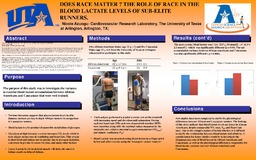
ATTENTION: The works hosted here are being migrated to a new repository that will consolidate resources, improve discoverability, and better show UTA's research impact on the global community. We will update authors as the migration progresses. Please see MavMatrix for more information.
Show simple item record
| dc.contributor.author | Azuogu, Nicole | en_US |
| dc.date.accessioned | 2013-06-11T19:29:50Z | en_US |
| dc.date.available | 2013-06-11T19:29:50Z | en_US |
| dc.date.issued | 2013-06-11 | en_US |
| dc.identifier.uri | http://hdl.handle.net/10106/11750 | en_US |
| dc.description.abstract | Lactic Acid is a byproduct of anaerobic metabolism. In the absence of oxygen, pyruvate undergoes fermentation instead of entering into the pyruvate dehydrogenase complex, which occurs during aerobic glycolysis. During fermentation, pyruvate is reduced to lactate. At about 50-70% of VO2max, there is a substantial increase in lactate accumulation, otherwise known as the Lactate threshold. At this work rate, energy is obtained from glycolysis. Glycolysis at high intensity exercise increases CO2 levels which in turn trigger an increase in ventilation and heart rate. This system is short lived and fatigue sets in quickly due to glycogen depletion, a decrease in pH due to excess H+ ions, and many other factors. Blood lactate levels are a reflection of the amount of lactic acid present in the muscle. | en_US |
| dc.description.sponsorship | Wilson, Judy, Ph.D. | en_US |
| dc.description.sponsorship | Heddins, Brad | en_US |
| dc.language.iso | en_US | en_US |
| dc.subject | Lactic acid | en_US |
| dc.subject | Glycolysis | en_US |
| dc.subject | Exercise blood lactate accumulation | en_US |
| dc.title | Does race matter? The role of race in the blood lactate levels of sub-elite runners. | en_US |
| dc.type | Presentation | en_US |
| dc.publisher.department | Cardiovascular Research Laboratory, the University of Texas at Arlington. | en_US |
| dc.publisher.department | Exercise Science Research Laboratories, the University of Texas at Arlington. | en_US |
| dc.publisher.department | Department of Kinesiology, the University of Texas at Arlington. | en_US |
Files in this item
- Name:
- Azuogu Research Poster.pdf
- Size:
- 1.352Mb
- Format:
- PDF
- Description:
- PDF
This item appears in the following Collection(s)
Show simple item record


